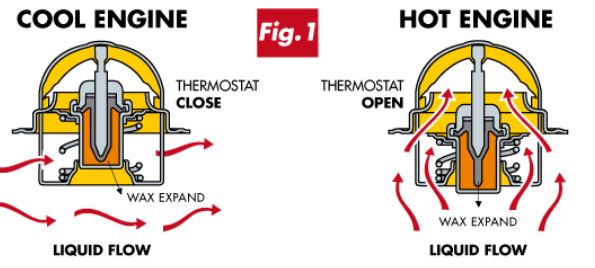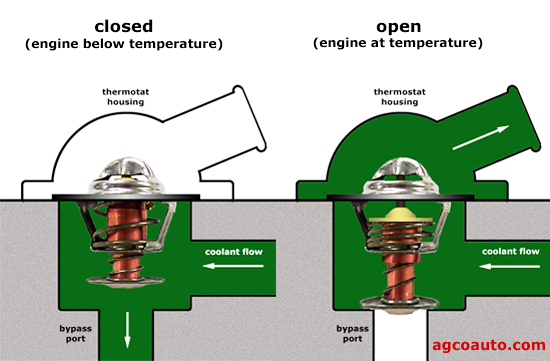A coolant thermostat is crucial for your car’s engine. It helps regulate the engine temperature.
But how does it work? The coolant thermostat is a small device in your car’s cooling system. It controls the flow of coolant to the engine. This helps keep the engine at the right temperature. If the engine gets too hot, the thermostat opens.
This allows coolant to flow and cool the engine. If the engine is too cold, the thermostat stays closed. This helps the engine warm up faster. Understanding how a coolant thermostat works can help you maintain your car better. It also helps you spot issues before they become big problems. Let’s dive deeper into how this tiny device makes a big difference in your car’s performance.

Credit: mte-thomson.com
Introduction To Coolant Thermostats
Understanding how a coolant thermostat works is crucial for car owners. It’s a small but essential component that helps your car engine run efficiently. In this section, we will explore what a coolant thermostat is and its role in your vehicle.
Role In Engine Performance
The thermostat controls the flow of coolant to the engine. When the engine is cold, the thermostat stays closed. This allows the engine to warm up quickly. Once the engine reaches its optimal temperature, the thermostat opens. It then allows coolant to flow through the engine. This process helps maintain the engine’s temperature.
Importance Of Temperature Regulation
Temperature regulation is vital for engine health. If the engine gets too hot, it can cause severe damage. Conversely, if the engine runs too cold, it can affect fuel efficiency. The thermostat ensures the engine stays within the ideal temperature range. This helps in prolonging the engine’s lifespan.
A functioning thermostat also improves fuel efficiency. It ensures the engine reaches its optimal temperature quickly. This reduces the time spent warming up the engine. It also helps in reducing emissions, making your car eco-friendly.

Credit: www.birdman308.com
Basic Components
The coolant thermostat is a vital part of your car’s engine cooling system. It helps maintain the engine’s temperature for optimal performance. Understanding the basic components can help you troubleshoot issues efficiently.
Thermostat Housing
The thermostat housing is a crucial part of the cooling system. It encases the thermostat and connects it to the engine and radiator. The housing is typically made of metal or plastic, designed to withstand high temperatures. It also ensures the thermostat stays in place, preventing leaks.
Here is a table describing the materials and functions of thermostat housing:
| Material | Function |
|---|---|
| Metal | Durable, withstands high temperatures |
| Plastic | Lightweight, resistant to corrosion |
Temperature Sensor
The temperature sensor plays a key role in the thermostat’s function. It monitors the engine’s temperature and sends signals to the thermostat. When the engine gets too hot, the sensor triggers the thermostat to open. This allows coolant to flow and cool the engine down.
Temperature sensors can be found in various types:
- Thermocouples
- Resistance Temperature Detectors (RTDs)
- Thermistors
The sensor ensures the engine operates within a safe temperature range. It helps prevent overheating and potential engine damage.
Operating Principle
The coolant thermostat is an essential component in an engine’s cooling system. It ensures the engine runs at its optimal temperature. The thermostat does this by regulating the flow of coolant between the engine and the radiator. Let’s delve into its operating principle through two key aspects: thermal expansion and the valve mechanism.
Thermal Expansion
The thermostat relies on a thermal expansion mechanism. Inside the thermostat, there is a wax-filled cylinder. As the engine heats up, the wax melts and expands. This expansion creates pressure.
When the temperature rises, the wax expands significantly. This expansion causes a piston in the thermostat to move. The movement of this piston is crucial in controlling the flow of coolant.
Valve Mechanism
The thermostat also contains a valve mechanism. This valve opens and closes based on the position of the piston. When the engine is cold, the valve remains closed. This restricts the flow of coolant to help the engine reach the proper temperature faster.
As the engine warms up, the expanded wax moves the piston. This movement opens the valve. The open valve allows the coolant to flow from the engine to the radiator. This flow helps maintain the engine’s temperature within the desired range.
The coordination of thermal expansion and the valve mechanism keeps the engine from overheating. It ensures the engine operates efficiently and lasts longer.
Types Of Coolant Thermostats
Understanding the different types of coolant thermostats is essential for maintaining your vehicle’s engine. Each type works in a unique way to regulate the engine’s temperature. Let’s explore the two main types: Wax Pellet Thermostats and Electronic Thermostats.
Wax Pellet Thermostats
The wax pellet thermostat is the most common type. It uses a wax pellet to control the flow of coolant. This thermostat has a simple design and is reliable.
Here’s how it works:
- The thermostat has a sealed chamber with wax inside.
- When the engine heats up, the wax melts and expands.
- This expansion pushes a piston, which opens the valve.
- Coolant then flows to the radiator, lowering the engine temperature.
When the engine cools down, the wax solidifies. This process allows the valve to close, stopping the coolant flow. This cycle repeats to keep the engine at the right temperature.
Electronic Thermostats
The electronic thermostat is more advanced than the wax pellet type. It uses sensors and a motor to control the coolant flow. These thermostats offer better precision and efficiency.
Here’s how they work:
- Sensors monitor the engine’s temperature and other conditions.
- Data from the sensors is sent to the engine control unit (ECU).
- The ECU processes this data and sends a signal to the thermostat.
- A small motor in the thermostat adjusts the valve position.
This adjustment allows precise control of the coolant flow. Electronic thermostats can respond faster to changes in engine temperature. This results in better fuel efficiency and lower emissions.
Both wax pellet and electronic thermostats have their advantages. Choosing the right one depends on your vehicle and driving needs.
Installation And Placement
The installation and placement of a coolant thermostat are crucial for its proper functioning. Knowing the correct location and following the installation steps ensure the engine runs efficiently.
Location In Cooling System
The coolant thermostat is typically placed between the engine and the radiator. It is often found near the top of the engine, in a housing connected to the upper radiator hose. This placement allows it to effectively regulate the flow of coolant, maintaining the engine’s optimal temperature.
Installation Procedures
Installing a coolant thermostat involves several steps. Below is a simple guide:
- Prepare the Vehicle: Ensure the engine is cool. Disconnect the battery for safety.
- Drain the Coolant: Place a container under the radiator. Open the drain valve to release the coolant.
- Remove the Thermostat Housing: Locate the thermostat housing. Use a wrench to remove the bolts securing it.
- Take Out the Old Thermostat: Lift the housing. Remove the old thermostat and gasket.
- Install the New Thermostat: Place the new thermostat in the housing. Ensure it is seated correctly.
- Replace the Gasket: Install a new gasket to prevent leaks.
- Reattach the Housing: Secure the housing with the bolts. Tighten them properly.
- Refill the Coolant: Close the drain valve. Refill the radiator with the appropriate coolant.
- Reconnect the Battery: Reconnect the battery. Start the engine to check for leaks.
Following these steps ensures the thermostat is installed correctly, preventing engine overheating and ensuring efficient cooling.
| Step | Action |
|---|---|
| 1 | Prepare the Vehicle |
| 2 | Drain the Coolant |
| 3 | Remove the Thermostat Housing |
| 4 | Take Out the Old Thermostat |
| 5 | Install the New Thermostat |
| 6 | Replace the Gasket |
| 7 | Reattach the Housing |
| 8 | Refill the Coolant |
| 9 | Reconnect the Battery |

Credit: www.agcoauto.com
Common Issues And Troubleshooting
Coolant thermostats are vital for regulating engine temperature. Sometimes, they face issues. Understanding common problems helps in fixing them quickly. Below are some frequent issues and ways to troubleshoot them.
Stuck Thermostats
A thermostat may get stuck in one position. If it gets stuck open, the engine runs cold. This can lead to poor fuel economy. If stuck closed, the engine may overheat. Overheating can cause severe damage. Regular checks can help identify this problem early.
Inconsistent Temperature Readings
Inconsistent temperature readings indicate a faulty thermostat. You might see the gauge fluctuate often. This can confuse the engine control unit. It might lead to erratic engine performance. Replacing the thermostat usually resolves this issue. Regular monitoring is key.
Maintenance Tips
Maintaining your coolant thermostat is crucial for your car’s health. Neglecting it can lead to engine overheating or poor fuel economy. Here are some maintenance tips to keep your coolant thermostat in top shape.
Regular Inspections
Check your coolant thermostat during regular engine maintenance. Look for signs of wear or damage. Listen for unusual noises from the thermostat area. Test the coolant temperature to ensure it is within the normal range. Inspect the surrounding hoses for leaks or cracks.
Replacement Guidelines
Replace your coolant thermostat every 50,000 miles. If you notice engine overheating, replace it sooner. Use the correct thermostat for your vehicle model. Follow the manufacturer’s recommendations for proper installation. Always replace the gasket when installing a new thermostat. This ensures a proper seal and prevents leaks.
Impact On Engine Efficiency
The coolant thermostat plays a key role in maintaining engine efficiency. It regulates the engine temperature to ensure optimal performance. A well-regulated engine runs smoother and lasts longer. Let’s dive into how it impacts fuel consumption and emissions.
Optimal Fuel Consumption
Maintaining the right engine temperature is vital for fuel efficiency. The coolant thermostat opens and closes to keep the engine at an ideal temperature. This ensures the engine runs efficiently, using fuel effectively. When the engine warms up quickly, it burns fuel more efficiently. This results in better mileage and cost savings.
Reduced Emissions
Controlling engine temperature also helps reduce harmful emissions. A properly functioning thermostat ensures the engine reaches its optimal temperature faster. This reduces the amount of unburned fuel released as pollutants. Consistent temperature control keeps the engine running cleaner. Lower emissions mean a healthier environment and compliance with regulations.
Frequently Asked Questions
What Is A Coolant Thermostat?
A coolant thermostat controls engine temperature. It regulates the coolant flow, helping the engine run efficiently.
How Does A Thermostat Regulate Engine Temperature?
It opens and closes based on temperature. When the engine is cold, it stays closed. As it heats up, it opens.
Why Is A Coolant Thermostat Important?
It prevents engine overheating. It ensures optimal engine performance by maintaining proper temperature.
Can A Faulty Thermostat Affect Engine Performance?
Yes, a faulty thermostat can cause overheating or underheating. This can damage the engine and reduce efficiency.
How Do You Know If Your Thermostat Is Failing?
Common signs include engine overheating, poor fuel economy, and fluctuating temperature gauge. Replace it if needed.
Conclusion
Understanding how a coolant thermostat works is crucial for car maintenance. It ensures your engine stays at the right temperature. This prevents overheating and damage. Regular checks can keep your thermostat in good shape. Always follow your car’s maintenance schedule.
Doing so will extend your car’s life. Remember, a well-functioning thermostat is key. It keeps your engine running smoothly. Don’t ignore any signs of thermostat issues. Catching problems early can save you money. Keep your engine cool and efficient. Your car will thank you for it.
